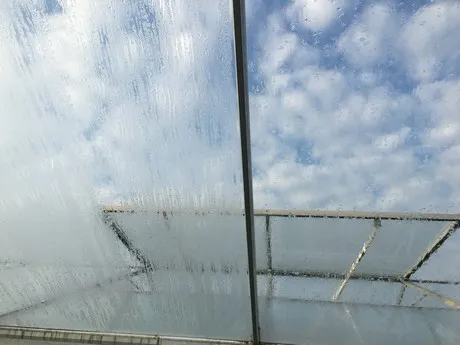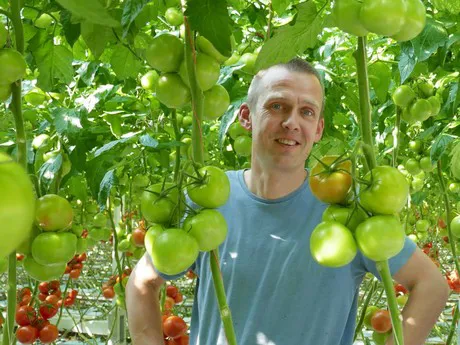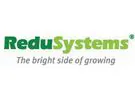For crops that are switched in the summer, this is the ideal time to apply AntiCondens to the inside of the greenhouse cover. It is a good preparation for the coming humid season, when condensation droplets block valuable light. Tomato grower Paul van Paassen has been using AntiCondens for three years, realising a light gain of 7 to 9 percent.
The inside of a greenhouse cover is covered with condensation for a large part of the year. This blocks a great deal of light, precisely during a time when every sun ray is needed by the crop. When water vapour condenses in the form of large droplets, light transmission drops by 9% according to the calculations performed by Wageningen University & Research. Practice shows that few growers are aware of how much light loss this problem causes.
The optimally light penetrable water film on the inside of the greenhouse cover is simple to achieve: by applying AntiCondens.

Left: without AntiCondens; right: with AntiCondens
Additional light gain
AntiCondens distributes water vapour in a fine film across the glass. This easily improves light transmission by 5%. This also solves the problem of falling droplets in the greenhouse. When these droplets land on the crop, they facilitate the germination of moulds such as mildew or botrytis. As a result, the application of AntiCondens also has a crop protection effect: the crop clearly becomes less wet. The water runs to the condensation gutter.
The product must be applied to dry glass. For crops that are switched during the summer period – such as cucumbers, gerberas, chrysanthemums and strawberries – this is the ideal time. This is because working in an empty greenhouse or greenhouse compartment is far more practical. Furthermore, it is also possible to apply AntiCondens in a greenhouse with a crop in it, but then it is recommended that you test if the crop is sensitive to this treatment. Our own tests show that there is no problem with tomatoes, cucumbers and gerberas, but that it can cause some damage to roses.
There are different methods for applying AntiCondens: specialised equipment is used that rides on the lower heating pipe rail system (common in vegetable crops) while evenly applying Anticondens or a manual application with a spray lance. After application, the product needs to dry completely. It will then be effective for at least a year, however, if the greenhouse is cleaned using a cleaning agent, it will be washed off.
Van Paassen: 7 to 9% light gain due to AntiCondens
Tomato grower Paul van Paassen in Bleiswijk in the Netherlands now has three years of experience with AntiCondens on glass; more than anyone else (AntiCondens on plastic has been around much longer). "We rent a spray cart from an agricultural leasing company so we can apply AntiCondens ourselves. This cart moves at forty metre per minute along the pathways and sprays AntiCondens against the glass. This way the product is perfectly applied to the glass," he says.

In the past he cultivated the robust truss tomato variety Merlice. Today he grows the specialty tomato Strabena, a tasty small variety that because of its unique shape is known as the 'strawberry tomato' and is sold under the brand name Rimini.
The crop rotation takes place in November, a period during which the greenhouse cover is almost continuously moist.
"It is important to apply the product on a dry day. Furthermore, it is ideal if the greenhouse is empty. The product, renting the equipment and labour entail extra costs, but all in all the results are positive: production is considerably higher," he says.
He has been positive about the results for three years. "The glass is far less wet; you can easily see this. And that results in a light gain. Mardenkro took measurements here in the spring and in comparison to an untreated section, the light gain was 7 to 9%. This is a considerable amount and translates into higher production."
For more information Mardenkro
Mardenkro
www.redusystems.com
